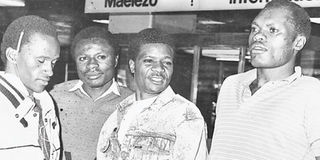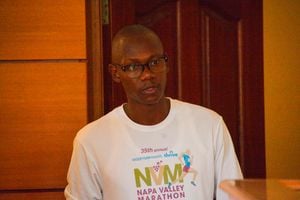Sammy Taabu: Tireless, defensive midfielder like no other

Sammy Taabu (second left) with his team mates from AFC Leopards (from left) reserve goalkeeper Dan Njuguna, Francis Kadenge and Dan Akoi at the JKIA before departure to Zaire (now DR Congo) for a continental assignment in May 1988. PHOTO | FILE | NATION MEDIA GROUP
What you need to know:
- The village boy, who rose to become one of the best players in the country, suffered from a heart condition first noticed by his youth coach Nyongesa those early years when the talented youngster could stop, short of breath in the middle of a run. He played with the condition throughout his successful career
- Sammy Taabu, defensive midfielder for Harambee Stars’ Challenge Cup winning teams of 1981, 1982 and 1983 lived with a bad heart.
We live to win the small and big battles that life throws at us every day and to defeat enemies such as disease.
Some of these enemies have relentlessly pursued us since we became guests in this world. Tragically, they sometimes have their way. And when that happens, they live in their wake unspeakable sorrow.
Mercifully, beautiful memories rush to fill the haunting vacuum, and in time, they are all that is left, when the pain and grief and sometimes anger, ebb away.
Sammy Taabu, defensive midfielder for Harambee Stars’ Challenge Cup winning teams of 1981, 1982 and 1983 lived with a bad heart. He courageously willed himself to overcome its debilitating restrictions and propelled himself to fly his country’s colours, never lamenting to anyone his precarious existence. But the illness in the heart just bid its time. Last week, it claimed him.
Taabu was an obsessive fitness enthusiast. He used to say: “Train hard to make the game easy.” Last Thursday, he went to the Railway Training Institute to join his colleagues for a kick-about. He arrived late and chose to let them finish before he could go through the paces on his own. That done, he got into his car and they happily opened the main gate for him. He looked all hale and hearty.
But he drove only 10 metres before stopping in the middle of the road. The alarmed gatekeeper raced to find out what the problem was. He found him unconscious. He had suffered a massive heart attack. Sammy Taabu was dead. First, they transferred his body to Chiromo Mortuary and then the following day, they buried him at Kariokor Muslim Cemetery, in accordance with Islamic traditions. Thus ended a small sub-chapter of Harambee Stars history.
Taabu was in the first class of the first Olympic Youth Centre to be established in Kenya. This was in Nakuru in 1975. His coach was the revered Sammy Nyongesa who remembers him well.
“We were neighbours,” he told me in the wake of his pupil’s death. “We lived in the Railway Quarters. His father worked for the railways. When Bernhard Zgoll came from Germany and established the first national youth centre in Nakuru, he asked me to scout for the best 15-16 year olds I could find. Taabu and his younger brother, Dick Anyanga made the list.”
ORIGINAL CENTRE
Many are called, so we are told, but few are chosen. After Nakuru, the Olympic Youth Centres would spread to Mombasa, Nairobi, Kisii and Kakamega and form the nursery of the national team. These are the names of the 15 and 16 year-olds who formed the original centre in Nakuru. (Enjoy their nicknames, too): 1. Ernest Maningi “Amaral World Stopper” – Captain 2. Nick Okama “Nikibue” 3. Salim Taabu “Luambo” 4. Dick Anyanga “Kid” 5. David Baraza “Opata” 6. George Odongo “Mao Tse Tung” - 1st goalkeeper 7. Christopher Kidete – Goalkeeper 8. Pius Ochieng 9. Benjamin Avedi 10. Charles Obange 11. George Ojwang 12. Daniel Rono 13. Philip Siwa “Kifaru” 14. Patrick Olimba “Canon” 15. Patrick Onyango – goalkeeper.
Of these 15 that were called, how many made it to Harambee Stars? Only “Luambo”, the boy with a bad heart and his younger brother, Dick Anyanga.
“They called him Luambo because he was a big fan of Franco Luambo Luanzo Makiadi,” the Congolese musician, Nyongesa told me. And there was fun, even for the quiet boy who enjoyed his own company.
Taabu’s father was once transferred to work in Tanzania. When he returned, he brought with him a Tanzanian accent in his Swahili. Taabu enjoyed mimicking it, and his team mates egged him on. Laughter reverberated in the training pitch and the dressing room.
But Nyongesa, ever so attentive to detail and maintaining a tight bond with his charges, had noticed something ominous. Taabu – Salim Tabu of Nakuru later became Sammy Taabu of Kenya – could not run one length of the pitch without stopping. Nyongesa quietly investigated and confirmed to his great distress that the boy had a heart condition. One day, an Israeli specialist, on a mission of his own in Nakuru, stopped to see the boys play at Menengai High School, their base.
FURTHER EXAMINATION
He loved what he saw. Nyongesa sat him down. “There is a good boy with a weak heart,” he told the Israeli. “What can we do for him?”
The Israeli doctor examined Taabu and determined that he could go on as he was but it was better if he was subjected to further examination and corrective surgery, if necessary, done. That never happened. Taabu went through a full career with the condition that would eventually fell him.
The irony of all this is that Taabu was playing in the particularly demanding role of defensive midfielder, the one played by Victor Wanyama today. It is the heart of the team and requires a lot of stamina. Because of his courage, Nyongesa took a liking for him. In 1977, he went with the national team to play in the Cecafa Challenge Cup in Somalia. The tournament coincided with a national youth tournament in Mombasa featuring all the country’s provinces.
Nyongesa told his charges: “I won’t be with you, much as I wanted to. I must be with the national team. You, Taabu, I am making you the caretaker of the team. Not coach, caretaker.”
Everybody agreed the coach had made a wise decision. The boys went to Mombasa and played their hearts out and returned to Nakuru with the Cup.
And when they were reunited with the coach, the party lasted long. The remnants of that team and others who succeeded them are the ones who in January this year threw a bash for Nyongesa in appreciation of his lifetime work with the youth of this country.
At Harambee Stars, Josephat Murila, the eternal centre-half universally known to Kenyans as Controller, remembers Taabu as “a strong character. He was quiet – “hakuwa na maneno mengi” – but when you tasked him with a role, he did it to the fullest. He liked keeping to himself.”
What was he thinking about? His heart? His position? Both? We shall never know. But he would have had good reason to worry about his position. We reporters of that time thought we knew who would play where even before Marshall Mulwa released his list. We knew that number one would be Mahmoud Abbas, we knew that number two would be Hussein Kheri, that number three would be Peter Bassanga Otieno, number four Bobby Ogolla, number five Josephat Murila, number seven Ellie Adero, number eight Wilberforce Mulamba, number nine JJ Masiga, number 10 Jacaranda Ouma and that number 11 would be Ambrose Ayoyi.
But who would be number six? It would either be Sammy Taabu or Jared Ingutia. We could never be sure. And sometimes they played in the same team, with Ingutia playing offensive midfielder at number 10. But Taabu, when he played, showed us what inexhaustible energy is all about. What is the best quality of a defensive midfielder? It is the ability to “see” everybody. Taabu did.

Sammy Taabu (standing) in action for AFC Leopards in this undated photo. PHOTO | FILE |
Peter Lichungu, his one-time team mate told me of the joyous occasion in Zanzibar when they celebrated his wedding. He remembered: “Very colourful, very Islamic.” Death is the end of the account, the good and the not so good. But it is also the beginning of memories. Sammy Taabu’s have begun.
For me, it is the memory of just how beautiful a town Nakuru was when Taabu started his career as a student at Afraha Secondary School. Nyongesa’s employer, Kenya Farmers Association, had a team which trained at the Rift Valley Sports Club every weekday between 2 and 5pm. KFA then made way for the school kids, Taabu among them.
Later, the Youth Centre migrated to Menengai High School. The town, then reputed to be the cleanest in East Africa, was a football mecca. Abeingo, Nyanam, KFA, Transcom, all thrived under the legacy of Nakuru All Stars, independent Kenya’s first national league winners.
For the majority of Kenyans of my generation, of course, it is what he did with Harambee Stars that they will cherish. All those honours are now but a beautiful memory.
The spectacular duels with Taifa Stars in Dar es Salaam in 1981 and especially with Uganda Cranes at Nakivubo Stadium in 1982 are ours for keeps and the grateful fans who bore witness to them salute his memory and wish him a fond goodbye. He was a member of the class of our best.
At 58, his ailing heart has given in and he rests now, his earthly journey at an end.




